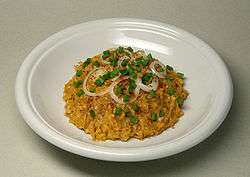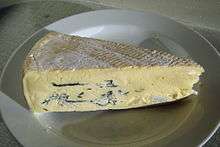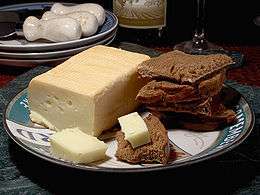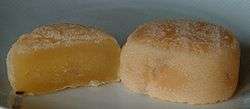List of German cheeses
Cheeses have played a significant role in German cuisine, both historically and in contemporary times. Cheeses are incorporated in the preparation of various dishes in German cuisine.[1] Germany's cheese production comprises approximately one-third of the total for all European-produced cheeses.[1]

Bavarian Obatzda, made from camembert, butter, onions and spices
German cheeses

Allgäuer Bergkäse
- Allgäuer Bergkäse – Prepared in Allgäu from unpasteurized cow's milk, it is ripened for a minimum of four months and has a smooth texture.[2]
B

Butterkäse

Cambozola cheese
- Backstein – similar to Limburger, it is processed in a brick shape.[3]
- Bergader - similar to italian Gorgonzola or french Roquefort.
- Bonifaz – a soft, white mold cheese.[4][5][6]
- Butterkäse – translated as "butter cheese" in German, it is a semi-soft, cow's milk cheese that is moderately popular in Germanic Europe, and occasionally seen throughout the rest of the world.
C
E
- Edelpilzkäse – Edelpilzkäse is a fine blue-veined cheese with a pale ivory paste. It is similar to Roquefort, but milder because it is made with cow's milk. Edelpilzkäse is made by mixing cow's milk with Penicillium spores. The mold grows within the cheese, giving the cheese the internal blue veining traveling vertically throughout and a tangy flavor. It is available in 45%, 50%, and 60% fat level.
H
- Handkäse – a German Protected designation origin (PDO) regional sour milk cheese (similar to Harzer) and is a culinary speciality of Frankfurt am Main, Offenbach am Main, Darmstadt, Langen and all other parts of southern Hesse. It gets its name from the traditional way of producing it: forming it with one's own hands.[7]
- Harzer – a sour milk cheese made from low fat curd cheese, which contains only about one percent fat and originates in the Harz mountain region south of Braunschweig.
- Hirtenkäse – or "herder's cheese", is a distinctive golden-colored, hard cow's milk cheese made in the Allgäu area of Southern Germany.[8][9][10][11]
- Hohenheim – a soft cheese, produced in a round form.[12]

Limburger and bread
M
- Milbenkäse – a specialty cheese made from quark and produced using the action of cheese mites. Historically, the cheese was produced in the Saxony-Anhalt/Thuringia border region of Zeitz and Altenburg districts; today it is produced exclusively in the village of Würchwitz, in the state of Saxony-Anhalt. Mites clinging to the cheese rind are consumed along with the cheese.
 Aged Milbenkäse
Aged Milbenkäse
O
Q
.jpeg)
German Quark in its usual creamy form
- Quark - a fresh, mild cheese, in Germany, quark is sold in small plastic tubs and usually comes in three different varieties, Magerquark (lean quark, virtually fat-free), "regular" quark (20% fat in dry mass) and Sahnequark (creamy quark, 40% fat in dry mass) with added cream. In addition to that, quark is sold lightly sweetened with a variety of fruits as a dessert (similar to yoghurt).
R
- Rauchkäse – a German variety of smoked cheese, known for being semi-soft with a smoky brown rind.[13] The most famous variety is Bruder Basil,[13] named for dairy entrepreneur Basil Weixler.
- Romadur – This is a cow's milk cheese with pungent flavor.[14] It is one of the most popular cheeses in Germany.[14]
S
- Spundekäs – a spiced cream cheese, originally from the region of Northern Rhenish Hesse. Nowadays, it is often enjoyed in the areas of Rhenish Hesse and the Rheingau area. It is especially popular in wine houses in the region, served with soft pretzels, accompanying regional wine. It is classically made of cream cheese and quark, and seasoned with salt, pepper and paprika. It is somewhat similar to Obatzda.
T
- Tilsit cheese – a light yellow semi-hard smear-ripened[15] cheese, created in the mid-19th century by Prussian-Swiss settlers, the Westphal family, from the Emmental valley.
W

Weißlacker, with paprika
- Weißlacker – (German for "whitewashed" due to the rind color) or Beer cheese is a type of cow's milk cheese that originated in Germany, but is now known worldwide. It is a pungent and salted surface-ripened cheese that starts out much like brick cheese.
Z
- Ziegel – prepared from cow's milk.[16]
 Light Obazter in a tub
Light Obazter in a tub A plate of Obatzda, garnished with white and green onion
A plate of Obatzda, garnished with white and green onion
gollark: I guess I'll have autobotrobot spy for me instead.
gollark: It helps me memetically control esolangs by telling me if anything interesting happens.
gollark: I used it!
gollark: AutoBotRobot is sentient and contains a GPT-███ instance.
gollark: Public chats contain various invisible apioformic entities which may disrupt use of regices.
References
- Ehlers, S.; Hurt, J. (2008). The Complete Idiot's Guide to Cheeses of the World. complete idiot's guide to--. Alpha Books. pp. 113–115. ISBN 978-1-59257-714-9. Retrieved 29 December 2019.
- Herbst, Sharon T.; Herbst, Ron (2010). The Cheese Lover's Companion: The Ultimate A-to-Z Cheese Guide with More Than 1,000 Listings for Cheeses and Cheese-Related Terms. HarperCollins. p. 60. ISBN 0062011553
- German Cooking: Five Generations of Family Recipes - Eleanor A. Hinsch. p .10.
- Country Life
- Eating Your Words: 2000 Words to Tease Your Taste Buds
- The Friends of Wine
- Food Dictionary: handkäse cheese
- Fond o'Foods website. Accessed March 17, 2009.
- Janet Fletcher, "Cheese Course: Hirtenkäse fans party when the cows come home," San Francisco Chronicle, February SF Gate website. Accessed March 17, 2009.
- German Deli site. Accessed March 17, 2009.
- Barbara Adams, "Cheese and Wine Pairing Recipe: Hirtenkäse Cheese and Gewürztraminer Wine," found at Barbara Adams' Beyond Wonderful website Archived 2008-12-01 at the Wayback Machine. Accessed March 17, 2009.
- German Cooking: Five Generations of Family Recipes - Eleanor A. Hinsch. p. 16.
- Encyclopedia of Cheese, igourmet.com
- Cheese For Dummies - Culture Magazine
- Fox, Patrick. Cheese: Chemistry, Physics and Microbiology. p. 200.
- German Cooking: Five Generations of Family Recipes - Eleanor A. Hinsch. p. 24.
This article is issued from Wikipedia. The text is licensed under Creative Commons - Attribution - Sharealike. Additional terms may apply for the media files.



